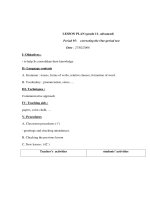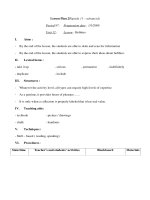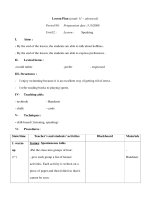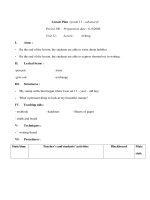Bài soạn môn học Tiếng Anh khối lớp 11 - Unit 12: Sports and pastimes - Section A, B
Bạn đang xem bản rút gọn của tài liệu. Xem và tải ngay bản đầy đủ của tài liệu tại đây (97 KB, 9 trang )
<span class='text_page_counter'>(1)</span>-1-. UNIT 12: SPORTS AND PASTIMES SECTION A: WHAT ARE THEY DOING? I. AIMS Students know some popular sports and pastimes in English. They can express which sports the play, ask and answer about sports and pastimes. II. PRESENTATION OF STRUCTURES. 1- Structures Present simple tense I play soccer. What sport do you play? Present progressive He/she is jogging What is he/she doing? 2- Vocabulary badminton skipping ropes soccer aerobics volleyball tennis III.. TEACHER AIDS: Cassette and pictures.. IV.. TEACHING STEPS: Teacher A.1. tables tennis swim play. jog. Students. - Set up the scene to Listen to the teacher introduce the activities in the Review the present pictures. Try to help them to review the tenses: present progressive tense. simple and present progressive. Notice the new word. Introduce new words and help them guess the activities in the lesson. Try to guess the activities in the pictures. Let them listen to the Listen to the cassette and cassette and read by read the sentences. themselves. Write them in the notebook. A.2. - Have them practice asking and answering with their. Lop11.com. Practice with partner.
<span class='text_page_counter'>(2)</span> -2partners about what the people Ask and answer in the pictures are doing. questions. Notes Call some pairs and let What is he/she doing? them practice loudly before He’s/she’s What are they doing? class. They are…. A.3. - Ask students to repeat the words indicating sports activities.. Repeat the words.. Introduce some sports the teacher plays then ask questions.. Listen to the teacher.. the. Notice their meanings. Try to answer, use the new words about sports activities.. Have them answer. Let them listen cassette and repeat.. to. Listen to the cassette and the repeat. Practice in pairs.. Then practice in groups of four or in pairs.. A.4. - Introduce the two Listen to the teacher’s characters Lan and Nam, ask introduction, then read the text them to read the text about carefully. Lan and Nam. Ask students to read then After reading the text try to answer the questions below. answer the questions. Write the questions and Check whether their answers in the exercise answers are right or wrong. notebook.. A.5. - Let them practice with their partners.. Practice with partners.. Try to tell about your Have them tell about favorite sports and ask your themselves and talk to their friends about theirs. friends about their favorite Write about your favorite sports. Lop11.com.
<span class='text_page_counter'>(3)</span> -3 Check the answer and sports. correct if there is any mistake. Listen to the teacher. Retell how to ask questions with interrogative words Write the notes in the “which” and “what” notebooks and learn by heart. - Which sport/what (sport) do you play? – I play… - What is he/ she doing? He/she is… Have them write the notes in their notebooks and learn by heart. Ask students to do exercises in the workbook from page 101 to 102.. Lop11.com. Notes Which sports do you play? I play soccer. Which sports does she play? She plays badminton What are you doing now? I’m playing soccer. What is she doing now? She’s playing badminton. Do exercises..
<span class='text_page_counter'>(4)</span> -4SECTION B: FREE TIME I. AIMS Students can express what they and people around spend their free time, and can talk about entertainment. They also learn how to ask questions with “How often” and use the adverbs of frequency “once, twice” II. PRESENTATION OF STRUCTURES 1- Structures Present simple What do you do in your free time? What does he/she do in his/ her free time? How often do you play sports? I play sports twice a week. How often does he/she goes jogging? He/ she goes jogging once a week. 2- Vocabulary Movies theater (go) fishing once, twice, three times video game III.. TEACHING AIDS Cassette and pictures. IV.. TEACHING STEPS: Teacher B.1. - Review new words indicating activities in spare time. Students Listen to the teacher. Have students listen to the Listen, repeat and look at cassette, repeat and look at the the pictures. pictures. B.2. - Have them practice in pairs Practice in pairs, using the “what do you do in your free question “What do you do in time?” your free time?” Call some pairs and let them practice before the class.. Lop11.com. Do as the teacher requests.
<span class='text_page_counter'>(5)</span> -5 Remark mistakes.. and. correct. the. Listen remarks.. to. the. teacher’s. B.3. - Re-explain the sentences Listen to the teacher from a) → f). Retell what the carefully. characters in section 1 do in their spare time. Pay attention to the teacher’s emphasis. Emphasize the third person Notice the agreement of the singular and the agreement of verbs after the 3rd person the verbs. singular or singular subject. Let students listen and read Listen and read again the sentences again.. B.4. - Let students practice in Practice in pairs pairs, ask and answer the Try to ask and answer the questions about the pictures in section 1. questions. Let them follow the model Practice in pairs, follow the dialogue, ask and answer. dialogue given. B.5. - Explain the aims and the Listen to the teacher requirement of the exercise. Ask carefully students to listen to the cassette and match the names with the Listen to the cassette. letters of the pictures. Match the names with the Show the pictures to the letters of the pictures. students before letting them listen to the cassette. Look at the pictures shown by the teacher. Let them listen to the Listen to the cassette and cassette and do their exercises. do their exercises. Let them talk to their Talk to partners to make partners. sure that the exercise is done Ask some students to check perfectly. whether they do the exercises Listen again to check the correctly or not.. Lop11.com.
<span class='text_page_counter'>(6)</span> -6 Let them listen again.. answer.. Call some students, ask Keys to exercises them to give the answers and Lien/f Minh and Nam/e tell them the keys to exercises. Tan/a Lan and Mai/b Lien reads. Minh and Nam play video games. Tan watches T.V. B.6. - Set up new situations to Listen introduce the adverbs of teacher. frequency: once, twice, three times.. carefully. Explain how to use these Notice the usage adverbs and give examples. adverbs of frequency.. to. of. the. the. Let students listen to the Try to give some examples dialogue. as the teacher does. Ask some questions and let Try to answer the teacher’s students answer to check their question. comprehension.. B.7. - Use charts describing Ly’s Listen to the teacher and diary to introduce her activities look at the charts. Practice with partner. following the models given. Ask as many questions as Call some students and possible. Correct the answers. check their answers. Try to talk about your own Ask students to tell about activities and ask about your friends themselves, use “how often…?” Notes Let them take notes. How often…? Once a week Ask students to write 5 Twice a week. Three/ four/ five times a sentences about their activities. week Have them do exercises on Do exercises as requested. page 102, 103, 104 in the workbook. Lop11.com.
<span class='text_page_counter'>(7)</span> -7SECTION C: HOW OFTEN? I. AIMS Students learn how to use the adverbs of frequency always, usually, often, sometimes, never and ask question with “How often…?” II. PRESENTATION OF STRUCTURES 1- Structures Present simple tense and adverbs of frequency. I always go fishing. They sometimes go fishing. He/she never goes fishing How often do they go fishing? How often does she go fishing? 2- Vocabulary Adverbs of frequency: always, usually, often, sometimes, never. III.. IV.. TEACHING AIDS Cassette and pictures TEACHING STEPS Teacher C.1. - Say the frequency loudly. Students. adverbs. of. Listen to the teacher. Explain the meanings of Notice the meanings of the these adverbs adverbs of frequency Let students listen repeat the adverbs.. C.2. - Introduce activities.. Ba. and. and. Lan’s. Tell them what Ba and Lan. Listen to the teacher and notice Ba and Lan’s activities. Listen to the cassette.. do Pay attention Let them listen to the teacher’s explanation cassette and then retell students about their activities. Read the text.. Lop11.com. to. the.
<span class='text_page_counter'>(8)</span> -8 Explain the whole text. Students read the text again. C.3. - Let them practice in pairs, Practice in pairs, ask and ask and answer the question answer questions. Try to about Ba and Lan’s activities. practice as much as possible. Use “How often…?”. C.4. - Ask questions about their Try to answer what the their own activities and let teacher asks. them answer. Let them practice in pairs, Practice in pairs, following do as the models given the models given. Ask them to copy the text Copy the text and write the then write questions and questions and answers. answers in the notebooks.. C.5. - Explain the listening Listen to the teacher exercise and introduce the explanation and introduction content of this exercise. Let them listen to the Listen to the cassette and cassette and match the adverbs do the exercise. of frequency with the appropriate pictures as requested. Call some students to check Listen again and check the the answers. answers and write in the notebooks. Let them listen again to correct their exercises.. Keys to exercises a) never d) often Give them the keys to b) sometimes e) usually exercises and let them copy in c) often the notebooks. a) Nga and Lan never go camping. Lop11.com.
<span class='text_page_counter'>(9)</span> -9b) They sometimes go to the zoo C.6. - Introduce the reading and read over. c) They often go to the park Let them read the text then d) They often play sports practice asking and answering check their answer and explain e) They usually have a picnic in the park new words if necessary. Ask them to write the notes in their notebook and memorize. Have them do more exercises in the workbook from page 104 to 105.. Lop11.com. Take notes and memorize. Notes How often…? They sometimes have a picnic Always often never Usually sometimes..
<span class='text_page_counter'>(10)</span>








